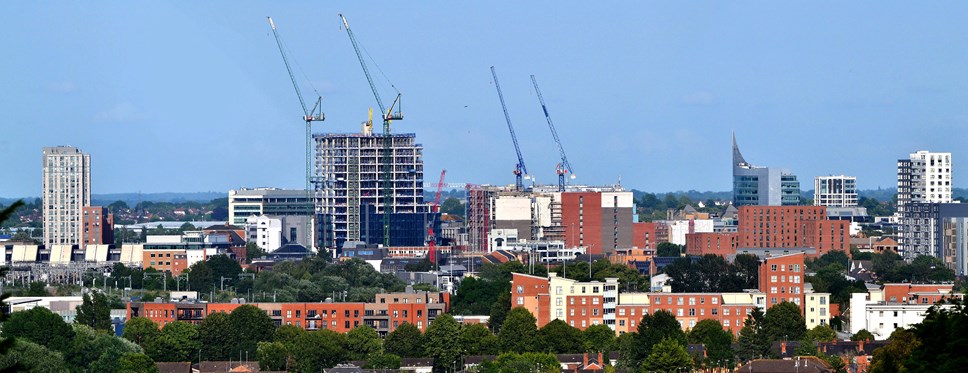
Electricity Capacity Constraints Threaten Reading’s Climate Targets
- The Council voices concern that electricity capacity issues in Reading are hampering the delivery of new low carbon homes
- Instances of new connections being restricted by Scottish and Southern Electricity (SSEN)
- Council now plans to work with the company and other local bodies to address the key issue
CONCERNS have been raised by the Council that electricity capacity issues in Reading could threaten the delivery of sustainable new homes and Reading’s wider response to the climate emergency.
An increasing number of new connections in the borough have been restricted by the local network operator, Scottish and Southern Electricity (SSEN). This means that larger housing developments – of 50 to 100 homes for example – may not be able to secure the necessary electricity network capacity to meet Council Local Plan requirements, if they use heat pumps and/or electric vehicle charging points.
With the electrification of heat and transport playing an essential role in tackling the climate crisis both nationally and locally, Reading’s drive to become a net-zero carbon town by 2030 will be impacted without significant investment in the network capacity and changes to how it is allocated.
Reading Borough Council is now proposing to work with SSEN, partners and neighbouring local authorities and bodies - and to lobby Central Government if necessary - to find solutions.
The Council’s concerns will be discussed at a meeting of its Policy Committee next week, on Monday September 25 https://democracy.reading.gov.uk/documents/s28410/Energy%20Network%20Capacity.pdf
The Council’s Local Plan is closely aligned with its net-zero ambitions and a key policy lever by which it can influence the delivery of sustainable new housing locally. It requires larger developments to install low carbon heating (effectively meaning heat pumps). For its part, the Council plans to install large solar installations and new electric vehicle charging infrastructure.
One example of the capacity issue in Reading occurred where a developer required 2,153kVa of capacity to install heat pumps to comply with the Council’s Local Plan policies on ‘zero carbon homes’. The application was rejected by SSEN due to its local network restriction. As a result, the number of heat pumps proposed are significantly reduced and the remaining properties will be heated with gas boilers instead.
Some of Reading’s pipeline priority projects which could fall foul of the new restrictions include: future large heat pump installations; the planned installation of more than 5,000 new charging points as part of its new Electric Vehicle Charging Infrastructure Strategy; and a potential future solar farm for Reading. Other partners across Reading and the wider region would face similar challenges as they seek to decarbonise buildings and vehicle fleets.
Micky Leng, Reading Council’s Lead Councillor for Planning, said:
“The impact of SSEN’s cap on electricity network connections puts at risk a range of development projects across our town and could derail the progress made locally in helping to tackle the climate crisis
“With new sustainable homes a part of the Local Plan, alongside the Council’s plans for more solar installations and investment in EV infrastructure, Reading is well-placed to build on that progress. Without serious investment in the local network and changes in how it is allocated however, we must question how much of it will be achievable.
“The Council now intends to work with SSEN and other local bodies who share our concerns to both shine a light of this issue, and to examine how we can influence key decision makers to bring about the changes needed, without which local councils and developers are effectively paralysed and locked into fossil fuels.”
As well as direct engagement with SSEN across all levels, Council officers have been working with the Greater Southeast (GSE) Net Zero Hub to collaborate with SSEN to pre-empt further network capacity issues. In the medium term, the creation of a Local Area Energy Plan, at Reading or Berkshire level with neighbours, could create a proactive, evidence-based, and data-driven approach to the whole energy system. Longer term, the creation by Government of a Regional System Planning role may help local government steer and manage local grid reinforcements in their local areas, but it is unclear how long it would take.
Notes to editors
Grid capacity constraints are not unique to Reading. A report was commissioned by the House of Commons Business, Energy, and Industrial Strategy Committee, titled “Decarbonisation of the power sector, Eleventh Report of Session 2022. The report highlighted that network constraints and issues securing a connecting to the grid are “impinging on the ability to deploy low-carbon technologies…The queue to connect to the grid is based on a first come first served basis, resulting in viable projects getting stuck behind those which may be speculative…..National Grid ESO expects 30-40% of projects in the queue to come to fruition, with many pipeline connections likely to be speculative”. The report also highlighted that District Network Operators had delayed the anticipatory investment required and this presented clear and present risks to the delivery of low carbon power.
The need for additional network capacity was emphasised by Reading and other stakeholders as part of engagement in conversations with SSEN whilst they were developing their ‘ED2 business plan’ (for the period 2024 to 2028). Reading’s Local Plan and other key strategic documents were sent to SSEN as part of the council’s engagement with this process, which provided the evidence base for the need for the additional capacity investment.

